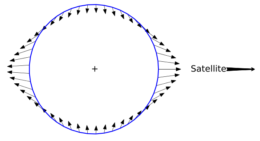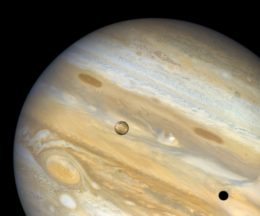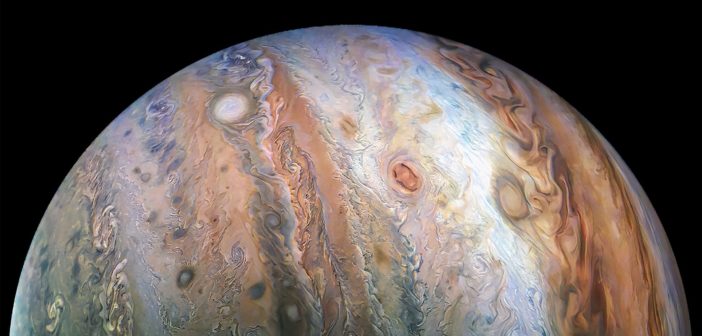As a moon orbits around its planet, the gravitational forces of the two bodies exert mutual pulls on one another. What happens to the inside of a gas-giant planet as a consequence of the tugs of its moons? New data from the Juno orbiter at Jupiter are providing answers!
Types of Tides
We needn’t look far to see how a moon’s gravity can influence its planet: anyone who’s witnessed low or high tide on a beach has experienced the effects of our own Moon.

The Moon exerts a differential gravitational pull on the Earth that manifests itself as tidal bulges on the sides of Earth facing and opposite the Moon. [Krishnavedala]
But hydrostatic tides are not the only type of tidal effect that the gravitational pull of moons can create. An additional effect is called dynamical tides, in which the gravitational influence of the moon induces oscillations in the interior of a gaseous planet. These waves could, if detected and understood, be used to probe the inside of the planet to learn about its structure and composition.
Until now, we’ve only detected the effect of hydrostatic tides in gas-giant planets — never the waves from dynamical tides. But new observations from the Juno orbiter are now shaking things up.
A New Probe on the Scene
The Juno probe was launched in 2011, and it arrived at Jupiter and began orbiting this nearby gas giant in 2016. One of Juno’s instruments is designed to map out Jupiter’s gravitational field by making careful measurements of minute changes in Juno’s velocity as it orbits. This detailed mapping allows researchers to detect the tidal response of Jupiter to the gravitational pull of its system of moons.
Intriguingly, Juno’s measurements show a tidal response that can’t be explained exclusively by hydrostatic tides. In a new publication, California Institute of Technology scientists Benjamin Idini and David Stevenson explore whether Juno may, in fact, be seeing evidence of dynamical tides in Jupiter.
Io-Induced Waves

This photograph, captured by Voyager 1 at Jupiter in 1979, shows Io and its shadow passing across Jupiter’s face. [NASA / JPL / Ian Regan]
The authors’ results suggest that Juno has indeed obtained the first unambiguous detection of the gravitational effect of dynamical tides in a gas-giant planet. Idini and Stevenson hope that we’ll be able to use these results — and future, even higher-precision data from Juno as it continues its extended mission — to explore Jupiter’s interior and answer long-standing questions about the inside of this gas giant.
Citation
“Dynamical Tides in Jupiter as Revealed by Juno,” Benjamin Idini and David J. Stevenson 2021 Planet. Sci. J. 2 69. doi:10.3847/PSJ/abe715


